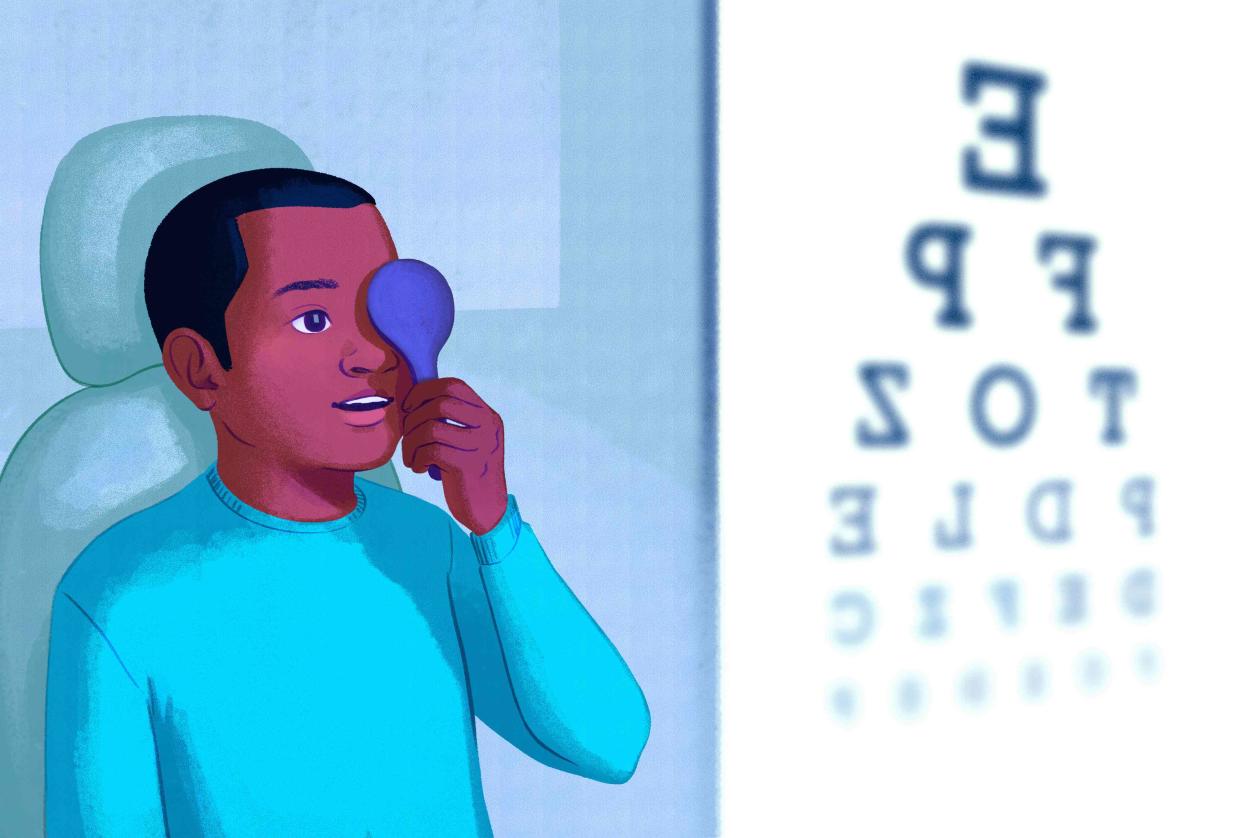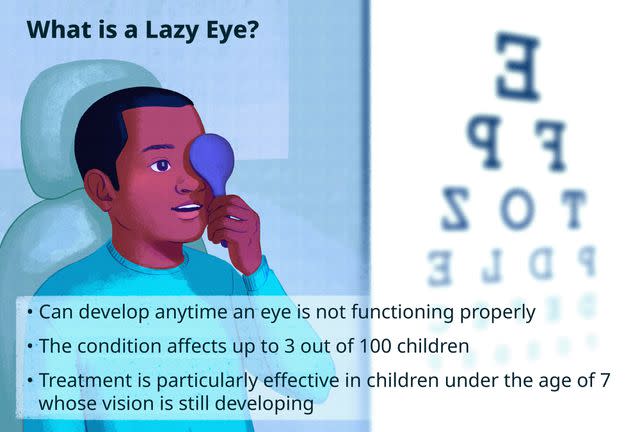Lazy Eye: Causes and Treatment

Illustration by Mira Norian for Verywell Health
Medically reviewed by Bryan M. Wolynski, OD
If you or your child has a lazy eye (amblyopia), one eye is sending unclear images to the brain. while both eyes can be affected, usually amblyopia affects just one eye, with the brain relying on the stronger eye for visual information.
A lazy eye, which some people are born with, is the primary source of vision loss in kids, but adults with vision trouble in one of their eyes also can develop lazy eye later in life.
This article will discuss the causes of lazy eye, vision problems it causes, diagnosis, treatment, and management.

Illustration by Mira Norian for Verywell Health
How Do You Get Lazy Eye?
Lazy eye can develop anytime an eye is not functioning properly and fails to send sharp images to the brain. It is most common in young children. The condition affects up to 3 out of 100 children. Typically this happens in the following instances:
If one eye over the other is much more nearsighted (able to see near objects more clearly than distant objects) or farsighted (able to see distant objects more clearly than near objects), the brain will begin to ignore the eye sending the fuzzier signals.
In cases of strabismus, a condition in which the eyes focus on different images, such as if one eye wanders to the side instead of looking straight ahead, the brain will have to choose which eye to rely on for information. It then begins to ignore the other.
If the normally clear lens (the structure that focuses light on the retina) develops a cataract (a clouding of the lens), after a while, the brain will tune out signals from the eye and will potentially never see normally.
These eye conditions are more likely to occur in some people than others. Those at risk for developing a lazy eye include children who were premature at birth or had a low birth weight and those who come from families where someone else has amblyopia.
Treatment: Can You "Fix" a Lazy Eye?
Effectively treating a lazy eye means first understanding what's causing it while aiming to correct the vision in the weaker eye. Treatment is particularly effective in children under the age 7 whose vision is still developing. Some treatments to consider include:
Wear glasses to sharpen vision, particularly in the weaker eye.
Put a patch over the stronger eye several hours a day to allow the brain to begin to rely on the weaker eye.
Temporarily blur vision in the stronger eye with atropine drops.
Surgically correct things interfering with vision, such as a drooping eyelid or a cataract.
Watch videos wearing a virtual reality headset to strengthen the weaker eye (in children ages 4 to 7).
Undergo muscle surgery to allow the eyes to work better together.
Eye doctors, such as ophthalmologists, encourage early treatment. Seek treatment even if the lazy eye is not discovered until later or there is some other obstacle. Don't consider it to be too late.
Research suggests that even adults can potentially improve their vision. Although it was once believed that the vision center of the adult brain could not hold on to any new experiences or information, research has shown that this is not true, and it is possible to improve vision somewhat.
Identifying Lazy Eye
It helps to know the symptoms of lazy eye to be able to identify it in your child or yourself. Symptoms can be subtle and include:
A tendency to shut one eye
Tilting the head to see better
Squinting to see more clearly
Eyes that appear to be working on their own rather than together
Eyes that are inwardly or outwardly turned
Trouble with depth perception
Decreased vision in one eye
Because signs in children may be subtle and difficult to discern, it's important to take children between the ages of 3 and 5 for regular vision screenings.
The cause of lazy eye will determine whether and when surgery is needed. For instance, if an infant has a dense cataract, surgery will need to be performed right away. But if the child is older and the cataract is just a small dot, the eye doctor may try other measures first, like patching the eye that doesn't have the cataract.
For children with strabismus (depending on their age), the eye surgeon may want to perform eye muscle surgery as early as possible. Those under age 4 tend to have better outcomes than older children.
While strabismus surgery typically ranges from $5,000 to $10,000 out of pocket, much of the cost usually is covered by insurance.
Vision Problems With Lazy Eye
If children with lazy eye are treated early enough (before age 5), they tend to recover fully, with no lingering vision problems. But if treatment is delayed, the child may have problems with depth perception. Those over age 10 may only recover some vision with treatment and may have some permanent vision loss in the affected eye.
Keep in mind that the impairment in the eye can be mild, with vision in the 20/30 range, or severe, leaving the child legally blind in the eye with 20/200 vision.
Amblyopia Daily Management
In many cases, amblyopia is managed daily with treatments like using drops or patching the stronger eye for a period of time.
If patching is used, you'll initially be asked to cover the stronger eye for about two hours daily. The eye doctor will then monitor vision every six to 12 weeks. If there is not enough improvement, you or your child will be asked to wear the patch up to six hours daily.
Getting a child to keep a patch on can be challenging but is of utmost importance. Some strategies to try if a child resists include the following:
Rewarding the child for using the patch with computer, device, or TV time
Motivating them with stickers on a patching chart or diary for hours when the patch is worn
The use of atropine drops is an alternative to patching. Each day a drop is placed in the stronger eye to widen the pupil. It then forces the other eye to be used for close-up tasks like reading.
Also, each day you can encourage your child to perform eye exercises to strengthen the weaker eye, such as the following:
Viewing dots
Coloring within the lines
Playing computer games
Following an object like a lollipop stick
Viewing stereograms (a two-dimensional image that can cause an optical illusion if viewed in a certain way)
Eye relaxation
These can be fun exercises for your child and work to alleviate lazy eye.
Summary
Amblyopia (lazy eye) usually affects one eye. With this, the brain begins to rely on vision signals from the stronger eye and ignore those from the weaker, "lazy" one. Reasons why a lazy eye may develop include a cataract, which makes it difficult to see out of the eye; strabismus, in which the eyes are focusing on different points; and a difference in refractive error, in which one eye sees better than the other.
Treatment ranges from patching the stronger eye or blurring with drops, to surgery to remove any obstruction that may cause the vision to be unclear, such as a cataract or drooping lid.

